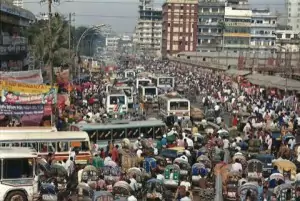 The world has a huge number of curious, fascinating, shocking, or otherwise impressive places to see. Gigantic megalopolises such as Tokyo or Shanghai, tropic paradises such as the Bora-Bora islands, amazingly contrasting cities such as Mexico City and Delhi—all these places are spectacular in their own ways. But there is a city on Earth that probably surpasses all other human-inhabited areas in terms of an extremely low quality of life. This city is called Dhaka, and a person who accidentally (and it is difficult to imagine that someone would travel there on purpose) comes to it will never forget what it has to offer to a visitor.
The world has a huge number of curious, fascinating, shocking, or otherwise impressive places to see. Gigantic megalopolises such as Tokyo or Shanghai, tropic paradises such as the Bora-Bora islands, amazingly contrasting cities such as Mexico City and Delhi—all these places are spectacular in their own ways. But there is a city on Earth that probably surpasses all other human-inhabited areas in terms of an extremely low quality of life. This city is called Dhaka, and a person who accidentally (and it is difficult to imagine that someone would travel there on purpose) comes to it will never forget what it has to offer to a visitor.

✅ AI Essay Writer ✅ AI Detector ✅ Plagchecker ✅ Paraphraser
✅ Summarizer ✅ Citation Generator
Its old name is “Dacca” and it is the largest city in Bangladesh, and its capital, located in the geographic center of the country, in the delta of the Ganges and Brahmaputra rivers. Due to such a location, Dhaka is one of the world’s main rice and jute-growing regions, since these crops grow abundantly here. These cultures also define Dhaka’s dominant industries, which are textiles and food processing. Dhaka is famous with its vast amount of Muslim mosques (over 700 mosques and historic buildings related to Islamic culture. The city was raised in the 10th century, and for a century, it was the capital of the Bengal kingdom—during the period between years 1608 and 1704. Later, it served as a trading outpost for British, Dutch, and French traders, and in 1765 it became Great Britain’s colony. During the Bangladesh Independence war, the city was almost ruined, but reconstructed several years later, and in 1982 its name was changed from “Dacca” to “Dhaka” (Virtual Bangladesh).
The most prominent fact about Dhaka (except its pollution rates, but this will be discussed later) is the density of its population and the pace of its growth. According to the World Bank, Dhaka’s current population is over 15 million people; during a period of 15 years, between 1990 and 2005, Dhaka’s population doubled from 6 to 12 million, making it the world’s fastest growing city. During the period between 2001 and 2011, Dhaka’s urban area and nearby rural environments increased in population by 5 million people. There are little to no cities in the world that would grow as rapidly as Dhaka has; perhaps, only Karachi, Jakarta, and Shanghai can compare with this city in terms of population rise (RISE). As the United Nations Organization predicts, by 2025, Dhaka, along with such megalopolises as Mexico City, Shanghai, and New York, will host more than 20 million people; perhaps the only city that will be able to beat Dhaka in this competition is Tokyo, with more than 35 million people predicted to inhabit it in only eight years. The reasons standing behind Dhaka’s rapid sprawling are mass migration, trade, and high rates of birth. At the same time, the majority of this population lives a life that few would envy; the Bangladesh Centre for Advanced Studies reports that at least 50% of Dhaka’s inhabitants live in slums, hand-built wherever possible: along the railways, on the river banks, and generally speaking, on every free piece of land. Urban geographer Nazrul Islam calls Dhaka “the megacity of the poor,” and estimates that the absolute majority (about 70%) of families living in Dhaka receive less than $170 per month; 40% of these families receive $80 or even less (CBS News).
Along with overpopulation, Dhaka experiences severe problems with water, air, and soil pollution. All possible categories of environment pollution indexes are “very high” in Dhaka. See for yourself. The overall pollution index is 95.91 points. Its air pollution index equals 85.80 points. Water pollution on this scale is 82.64; noise and light pollution indexes are high, equaling 75.78 points. The pollution of drinking water and its inaccessibility has remained Dhaka’s major problem for years; the index of this type of pollution is 65.54 points. Dissatisfaction with the low amount of trees and parks in the city, as well as the impossibility to spend quality time in it, cause the respective index to be estimated at “very high” as well—around 84.7 points. The city is extremely dirty (83.11 points), and the low quality of garbage disposal (81.08 points) does not contribute to the problem’s solution. At the same time, the indexes of purity and cleanliness are all located in “low” and “very low” sectors: on average, the index of overall cleanliness is around 19.6 points. As it can be seen, living in Dhaka is not only complicated due to economic reasons, but also dangerous for health due to horrible ecology.
Dhaka is one of the most densely populated megalopolises in the world, with perhaps the highest rates of population growth. However, this does not make Dhaka an urban paradise, or at least a place where people can live and work normally. In fact, the majority of Dhaka’s inhabitants live on less than $170 per month, in slums, and in an environment that is heavily polluted: air, soil, and water in this city are literally unusable. “The megacity of the poor,” Dhaka needs to solve its problems fast, otherwise this huge urban monster will most likely collapse in the upcoming decades.
Works Cited
- “Bangladesh City: Dhaka.” Virtual Bangladesh. N.p., n.d. Web. 02 Feb. 2017. <http://www.virtualbangladesh.com/the-basics/cities/dhaka/>
- “Dhaka, Bangladesh: Fastest Growing City in the World.” CBS News. CBS Interactive, 19 Sept. 2010. Web. 02 Feb. 2017. <http://www.cbsnews.com/news/dhaka-bangladesh-fastest-growing-city-in-the-world/>
- “A Look into Dhaka, Bangladesh—The Most Densely Populated City in the World.” RISE. N.p., 09 Mar. 2013. Web. 02 Feb. 2017. <https://risebd.com/2013/03/09/a-look-into-dhaka-bangladesh-the-most-densely-populated-city-in-the-world/>
- “Pollution in Dhaka.” Numbeo. N.p., n.d. Web. 02 Feb. 2017. <https://www.numbeo.com/pollution/in/Dhaka>
Follow us on Reddit for more insights and updates.





Comments (0)
Welcome to A*Help comments!
We’re all about debate and discussion at A*Help.
We value the diverse opinions of users, so you may find points of view that you don’t agree with. And that’s cool. However, there are certain things we’re not OK with: attempts to manipulate our data in any way, for example, or the posting of discriminative, offensive, hateful, or disparaging material.